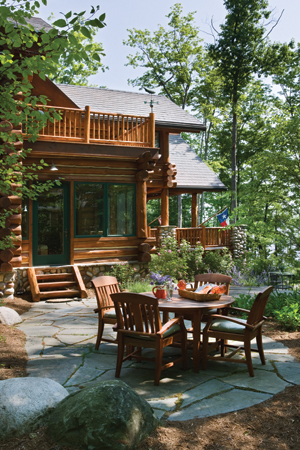If you’re like most Americans, you’ve spent the past several years watching economic events unfold with a moist eye and your fingers crossed that the worst is over. Well, we’ve got some good news for you—economists and housing authorities believe we’ve finally hit bottom and are starting to emerge from the recession. Not only that, but there are glimmers of recovery. The housing market has shown modest gains, and though it will be methodical and slow, according to experts like John Burns, founder of John Burns Real Estate Consulting, which analyzes market data and advises developers, builders, and investors on real estate trends, things are looking up.
Indeed this is good news for all of us, but it’s exceptionally exciting if you’ve always dreamed of owning a vacation log home, because this could be your best chance to make one of the smartest investments of your life.
“People who dream of owning a log home ‘one day’ usually don’t let that dream go,” says Jeremy Bertrand, national sales manager at North Carolina-based Log Homes of America. “The economy may have delayed their dream, but it has not killed it.” Indeed, his company has seen a renewed interest in second-home ownership across the country, with some pockets (such as the mountains of North Carolina and eastern Tennessee) being a bit stronger than others. He also says that, despite the downturn, log cabin enthusiasts have continued to put away money toward the purchase of their home and are now ready to start spending.

Maple Island Log Homes/photo by Roger Wade
That’s not to say there aren’t still a few challenges when it comes to the financial market, but times are looking better. Qualified candidates with a least 20 percent down who conform to a conventional (30-year fixed, non-jumbo) loan shouldn’t have much trouble obtaining a mortgage. And here’s a tip: You may find that community banks and lenders who specialize in log home financing may be easier to deal with than large conglomerate banks who sell their mortgages to Freddie Mac and Fannie Mae.
If you’re looking to your second home as an investment, not just a great place for a little R&R, you may want to get the wheels in motion quickly. When it comes to land, there’s still a lot of inventory out there, which means that prices continue to be competitive. But don’t think you’re going to get bargain basement prices for a parcel. The cost of land did drop over the past several years, but not as much as you’d think (with a few extreme exceptions). Ultimately, this is good news because it means that the value will hold steady or increase in the years to come, reinforcing that real estate is still a wise way to invest your money. And with interest rates remaining low, at least in the short term, your dollar will go further to making your dream home a reality.
And what of the look and feel of that dream home? When it comes to design, you can kiss the days of the McMansion goodbye. For the first time in memory, square footage of new home starts has declined, and sharply. Last decade, house sizes soared into the 5,000-square-foot and larger range. People finally realized that’s a lot of house to maintain, heat/cool, and clean, and, usually, much more house than you need. Cozy cottages in the range of 1,200 to 2,200 square feet and filled with versatile design features, exceptional details, and energy-saving amenities are where it’s at now. Designing useful, attractive outdoor living space is just as important as thoughtfully planning what’s inside. Kitchens are still a smart space to splurge, particularly if resale value is important to you. But don’t design your home for others. This is your house—your log cabin. It’s important to make it everything you want it to be.

